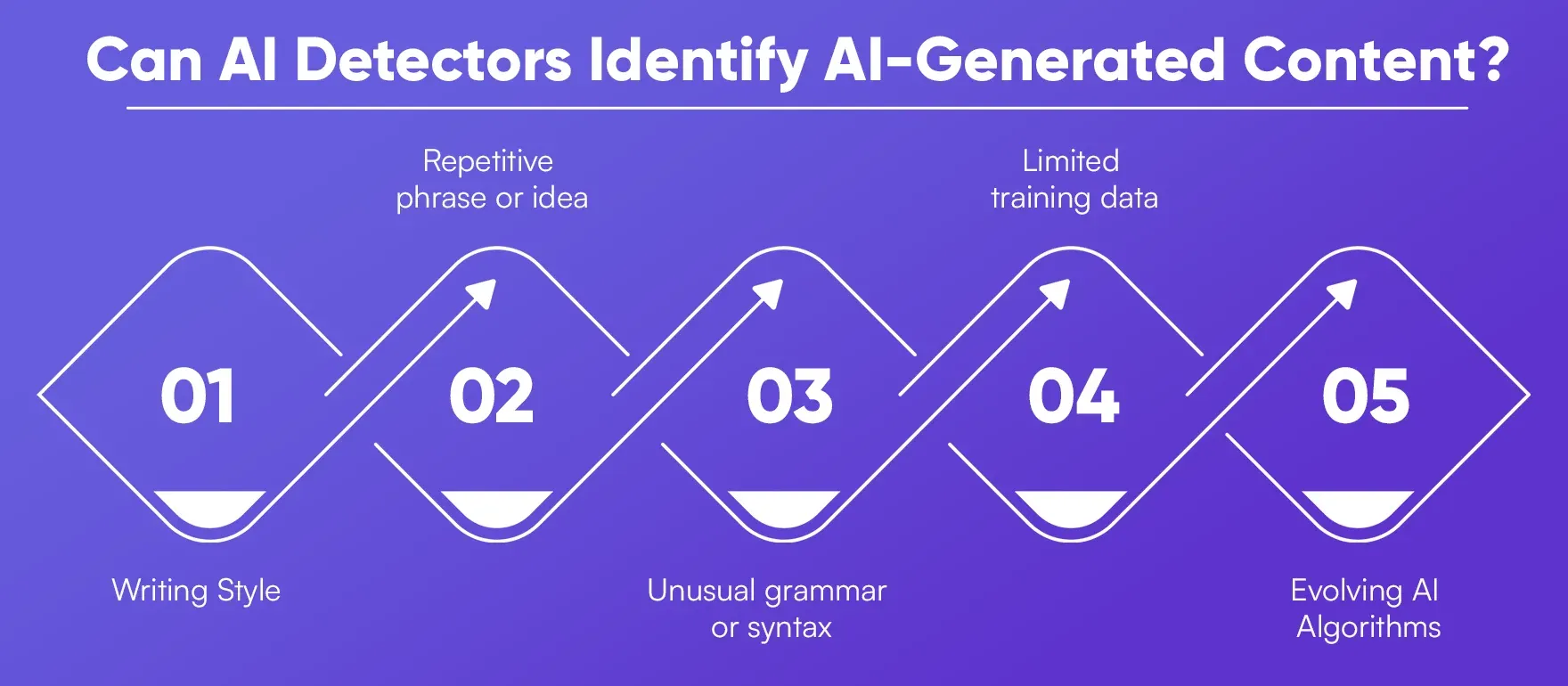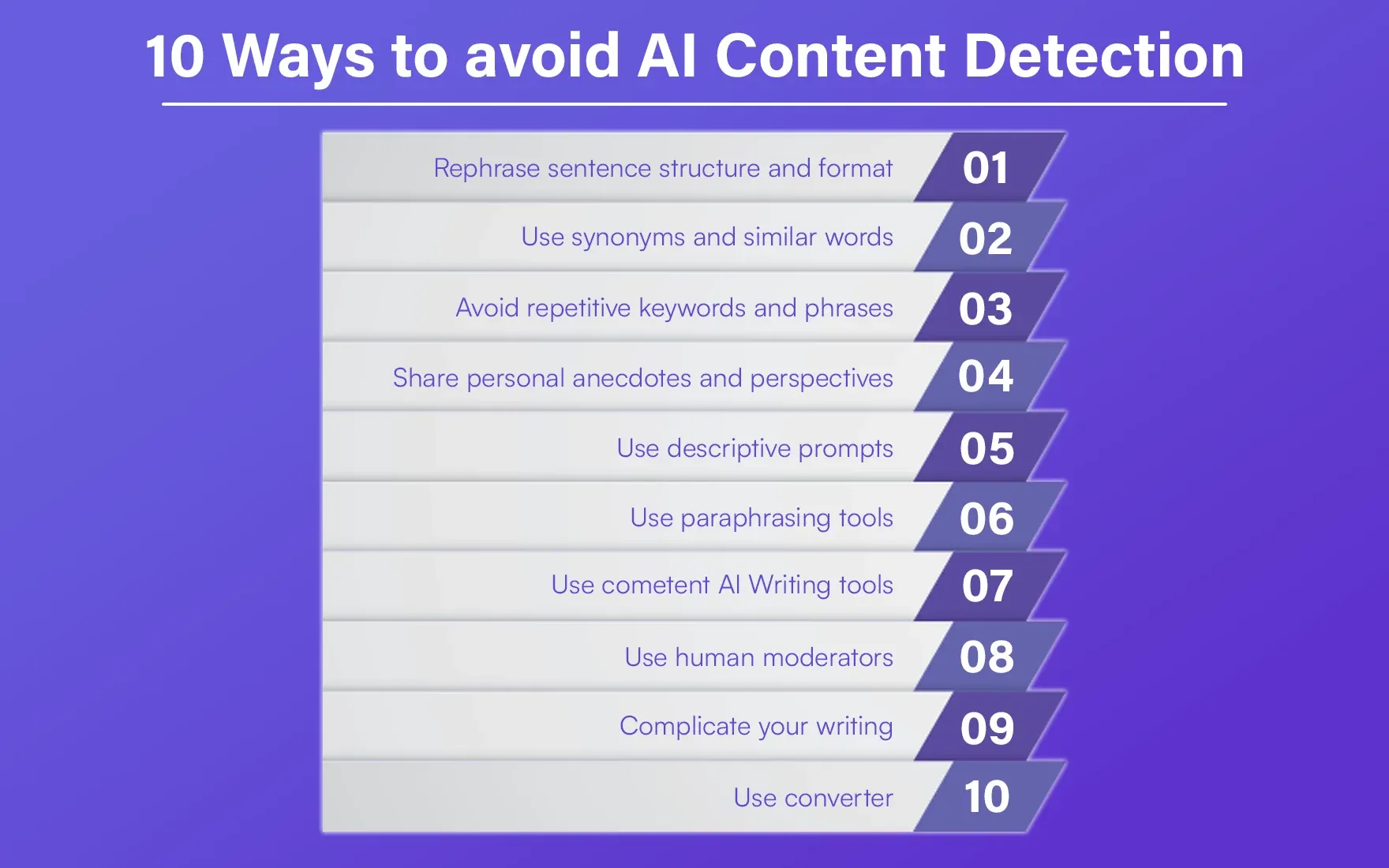Sign In
Welcome to AI Checker Sign in to continue your exploration of our platform with all its exciting features.
Forgot Password?
Don’t have an account ? Sign Up
Forgot Password
We'll Send You An Email To Reset Your Password.
Back to Login
Sign Up
Embrace the Future with AI Checker Sign up now and let's rewrite the possibilities together.
Already have an account? Sign In
Enter OTP
We'll send you an email to reset your password.
Back to Login
Enter OTP
We'll send you an OTP on your registered email address.
Back to Login
Confirm Password
Please enter your new password.
10 actionable tips to avoid AI detection in 2024
 Nathan Porter
Nathan Porter
TABLE OF CONTENTS
Quick Summary
What is AI Detection?
Importance of Bypass AI Content Detectors
Can AI Detectors Identify AI-Generated Content?
10 Ways to avoid AI Content Detection
Should you hide AI Content?
Key takeaways
Conclusion
FAQs
In a rapidly changing digital landscape, incorporating AI systems in content discovery is increasingly becoming a watermark with time. Nevertheless, little efforts have been made in resisting search via AI algorithms. In this paper, we describe practical guidelines on how to make your own AI-resistant content and equally retain freedom of speech by qualifying the use of techniques like sentence obfuscation and encoding for you to satisfy AI oriented discovery.
Quick Summary
This e-book presents practical tips on how to avoid AI detection when data is available. It highlights the importance of integrating AI with human expertise and includes sentence repeating, synonym selection, personal information embedding and more.Embrace AI as a more appropriate detection tool for higher accuracy and benefit.
What is AI Detection?
AI-based detection refers to the identification between human-authored content and machine learned models' generated content. To discover AI content, we usually analyze the writing style, dependency syntax structure, redundant expressions or lexical markers produced by text processors.
The use of AI-generated text has become more and more prevalent in recent years for digital publishers to SEO and content marketing, as well as image and video generation.
AI-generated text is important because the AI-generated feature's usage impact on perceived authenticity of content. Many times human writing generates a perception of being costly versus AI generated text.
This is might be due to the perception that a human writer has put a lot of time and effort into writing. Somehow, people associate more time with more valuable. It is also interesting looking at the use of AI writers in other situation such as outsource authoring material or simple academia research study.
Importance of Bypass AI Content Detectors
Surrounding yourself with AI content detectors is important in order for individuals and organizations to exercise their freedom of speech without fear of censorship. Advertisers use algorithms, that are often ableist racists , which can flag content, even though it is legal and harmless. If you cannot bypass the detector, you can not send your targeted message into a community of people who otherwise expect to dialogue about issues that should be analyzed critically.
Being able to assign an AI identity is particularly relevant when individual or groups share non-mainstream information or ideas, or express views, non-confornative to dominant norms or policy direction. Bypassing AI content detectors enables this users group to engage with others, evaluate ideas and question dominant current conventional.
Can AI Detectors Identify AI-Generated Content?
AI content detectors aren’t meant to be 100% perfect and will often have false positives. Since AI detection systems are built on the writing style and language pattern common in AI generated things, human written text imitating the same pattern can be wrongly categorized.
The tools aren't perfect and they often mistakenly identify human-written content as being AI-generated for a few reasons:

1. Writing Style
You may end up using sentence structures or wording similar to what you would get from an AI model.
2. Repetitive phrase or idea
You repeat the same words a lot in your writing. This is one of the easiest giveaways of fake AI content.
3. Unusual grammar or syntax
If you use unconventional grammar or syntax in your handwriting this could be detected by an AI recognition tool as indicative of AI generated content.
4. Limited training data
AI detection tools rely on training data to learn what differentiates human generated and AI generated features. If the training data of the AI detector is poor or biased, this can result in a less accurate tool and cause more false positives to occur.
5. Evolving AI Algorithms
As AI text models get better and better at replicating human-like language, the tasks that analytics tools use to detect AI will become more difficult to separate from humans as well.
10 Ways to avoid AI Content Detection
AI detectors rely on heuristics in order to detect if something has the hallmarks of being generated by an AI. So instead of having one trick up our sleeve to evade detection, we'll need many.
So the simple question “How to avoid AI content detectors?” I will answer with 10 tips on how, and any of them you can take to miss AI search.

1. Rephrase sentence structure and format
Changing vocabulary and sentence structure is likely to be most effective in defeating search algorithms that are looking for a combination of grammatical structure and sentence structure.
So, the quickest way of evading AI detection is just to reword your sentences or put them in a different order. Alternatively let another device do this for you more easily (and quickly). Breaking long sentences into shorter ones is helpful too.
Use synonyms and similar words
Changing words keeps AI away. Change a meaning-relevant word to its synonym. But be careful, the new substitution must make sense and include at least some information of the original wording.
AI tools often resort to simple, easy to grasp keywords. Moreover, uncommon words also help your write-up get distinguished. E.g. instead of happy and sad look for elated and depressed etc. it makes your writing unique as well.
3. Avoid repetitive keywords and phrases
AI tools tend to repeat the same words and phrases (like, isn’t it?). AI like ChatGPT is quite famous for its bias towards certain words. AI detection won’t have any hard time pointing out those repetitive and predictable writing style.
Well, yeah! You should actually avoid such repeated words in your content because it’s simple as well as important. It has a direct impact on how good detector-bots can detect that writing. Ultimately this will ensures your AI generated content is more genuine and of premium quality. So being natural by making sure of below will a 100% help:
Write in the first person. It’s like you’re talking about your own experience.
Use a mix of short sentences, and long sentences (in moderation). Don’t get stuck in one pattern.
Write like you talk. That includes asking questions, using spinners and more.
Use plain English. I never recommend using word traps.
4. Share personal anecdotes and perspectives
It’s you as a human that makes your real life stories and experiences pop, and it’s those stories people want to hear. I find AI struggles with this.
So if you are writing for yourself using AI then combine some of your own human writing with the AI text. Share tips, useful information, make what you write helpful in some way to others, that’s how you can connect. That’s how your words don’t sound too robot-like or become too easy for any AI to replicate.
5. Use descriptive prompts
AI content generators are all about faster content creation. But why do most of them hardly ever sound human? Well, it has a lot to do with how you incentivize them. Ditch the boring keyword prompts and use interesting ones instead. For example:
Boring keyword prompt:
Cooking is the process of preparing food by using heat. It involves a combination of ingredients and methods to create edible substance that has a use in our body and brain. Cooking is the art, technology, science and craft. Almost everyday people do cooking. Some common ingredients like bread, eggs or popcorns are popular for breakfast while some other sustenance or item like vegetables need a lot preparation such heating etc for dinner.
Mmm there’s something about homemade lasagna that just makes your mouth water. Your reader can almost smell the garlic and feel the heat in the kitchen as you explain how to make it, can’t they? They can really visualize themselves making it with you when you write a scene with descriptive language and all 5 senses- sight, sound, smell taste and touch. It pulls the reader into what you’re actually writing about… in this case, MAKING LASAGNA! How cool is that?
Prompts like this do more than inspire an AI to think or just “search engine optimize” it helps make the AI connect with PEOPLE.
Read more, How to Avoid AI Detection in Writing
6. Use paraphrasing tools
We have talked about the need for restructuring of sentence. If all your modification endeavors, done on your part, do not seem to yield much and the content is still marked as AI-generated then you can obviously take help of paraphrasing tools.
Apart from these there are other text editors also that can help you in achieving humanity related content. They work lightening fast, just opt them to pass AI exams. Below are two examples of many such Annotation Tools.
Quilbot: It really knows how to read the context of the text and adapt it to the character.
Wordtune: It comes in several fonts so you can pick your favorite one.
7. Use cometent AI Writing tools
Articles can be detected without any model. Seriously, you don’t need an AI detector for that. To avoid this, use AI writing tools where humans look like Objects.
With cool tools like Proco, basically you choose a use case and feed some text and voila- you get objectified things in seconds. It generates information from a superhuman point of view and then spreads it (also very efficiently mixed with human written content by AI).
8. Use human moderators
Human editors are very good at contextually correct editing content (i.e. no AI spamming), easy for a reader to understand (i.e. repetitive phrasing) and personal (i.e. it’s human-handed). It’s just something your brain can filter from using an over-used phrase… however much like anything in life, if you show someone repetition enough times – they will eventually ask you why you are acting like a jerk! Beyond a certain period of time.. human curators might also be able to pick why the content “looks” generative AI-ish too.. which again, makes their job easier.
9. Complicate your writing
How do I make AI text not recognizeable? Mess with your content!
When ai detectors were new people didn't know how they worked so they used to replace some parts/letters of their content with symbols like "i" would be replaced by "!" and "o" would be replaced by "0" etc
Of course, I don’t recommend doing this. By now we probably have enough clues on why something is considered AI generated and how to not do that. I’m posting it here, just in case you want to fail the AI detector project hard after trying your best.
And no, for our reader’s case knowledge level it’s not a good idea.
10. Use converter
There are AI that generates content, there is AI that detects AI, and then there are AI to Human content converting. (probably genius!)
You just have to Paste from anywhere your content. One click and you'll get it converted most probably will not be detected by any AI.
So why is it in No. 9 in the name? Well let me explain how these work. These will use some of our list points we went through earlier with tips like paraphrasing, sentence structure change ups, split the sentence, active voice and more. But really what you’re doing is re-purposing AI – yes that’s right if you’ve got the context to reuse it then go ahead it’s not going to vanish.
If you do need to use either- check, re-check and rework.?
Can Google detect AI Content?
Mostly, yes. I mean it has access to a lot of data and builds its own AI’s. It just seems strange that an AI can’t look at content.
But the real question is do you care? When people hear AI generated content they instantly think “Google won’t like it, the content won’t rank”. Am I right? But Google never asks if a human or an AI wrote something, as long as it helps answer a searchers query.
Should you hide AI Content?
Is it something embarrassing? Does it mean you are not smart or talented?
No.
Quite the opposite, it makes you adapt and understand trends (and can predict future too if I must add). Afterall, AI is the future, if not content generation. Now is about how to make best use of human writer + AI writer combo.
Key takeaways
- Use both AI and human writing to provide high quality information and smartest AI detectors.
- Make sure the content is written in an easy, friendly and honest language. No keyword spamming. Write better prompts to get more personal information.
- Get it sounding more human by rewording things to get rid of robot feels
Conclusion
In today’s ever-changing landscape of digital content creation, using AI tools to create such content has become more and more common. But how do you make sure your AI-created content doesn’t get flagged by an AI detector? The answer: a strategic approach. By implementing these actionable tips provided in this guide, not only will your content stay undetected, but also you’ll be able to ensure that the quality isn’t compromised either. After all, it’s the perfect combination of AI with human creativity that yields the best results in today’s digital era.
FAQs
1. Can Google detect AI-generated content?
Yes, Google has advanced algorithms that can detect AI generated content but what matters the most is whether the content provides value to readers no matter who has created it.
2. Should I disguise AI-generated content material?
No, there’s no want to cover AI-generated content material. Instead, awareness on creating content material that offers price in your target market, whether or not it’s generated via AI or human beings. Embrace the potential of AI as a software to assist you enhance your content advent method.
3. How do I be positive my content passes AI detectors?
You can in addition expand the chances of your content passing AI detectors by means of following the tips provided in this guide, rewording sentences, the use of descriptive cues or non-public examples – whilst preserving authenticity and quality.

Nathan Porter
Content writer at @Aichecker
I am a content writer at AI Checker Pro, where I craft engaging, SEO-optimized content to enhance brand visibility and educate users about our AI-driven solutions. My role involves creating clear, impactful messaging across digital platforms to drive engagement and support company growth.


